- Home |
- About |
- Contact Us |
- Privacy |
- Newsletter |
- Shop |
- Donate
Long Division with Money Worksheet
(Randomly Generated)

Welcome to our Long Division with Money page.
Here you will find our free worksheet generator for generating your own long division sheets with different currency amounts.
If you are looking to create your own custom-made long or short division worksheets then look no further!
We also have several worked examples showing long division with different amounts of money on this page so you can see how the method works.
Using the random sheet generator will allow you to:
- choose the number range and number of questions you wish the worksheet to have;
- print or save your worksheet and a corresponding answer sheet;
- choose your own title and instructions for completing the sheet - great for homework!
For optimal printing, please set your margins to zero on your print setup options.
To save your worksheets, select Print to PDF in the printing options.
If you have any problems with our Random Generator, please let us know using the Contact Us link at the top of each page.
Mobile View of Worksheets
Please note that our generated worksheets may have problems displaying correctly on some mobile devices.
This should not affect the printing of the sheets which should display correctly.
Long Division with Money Worksheet Generator
Here is our random worksheet generator for creating your own long or short division worksheets with money amounts.
Using this generator will let you create your own worksheets for:
- Dividing money amounts up to $100,000 (or £100,000) by a range of different numbers up to 99;
- Choosing exactly which divisors you want to include;
One of the best features of this generator is that you can choose individual values for the divisors for the worksheets (between 2 and 15).
This means that:
- if you were introducing long division for the first time, you could choose just to divide money amounts up to $10 by 2, 3 and 5.
- if you wanted to introduce dividing by two digits but you wanted to divide money amounts by 11 and 12, you could do that also.
- to access this feature, go to the 'Select divisors from a list' option.
There is also a decimal values option which you can turn on and off to select money amounts with and without decimals.
There are two currency options: $ and £.
To start creating your sheet, choose an option from the Number values box below.
Parts of a Long Division Equation

The dividend is the number being divided.
The divisor is the number you are dividing by.
The quotient is the number of times the divisor goes into the dividend.
The remainder is what is left over from the dividend when the divisor has been taken away as many times as it can be without leading to a negative answer.
The remainder can be a whole number, but it can also be expressed as a fraction or decimal.
Long Division with Money Worksheet Generator
4 Steps to Your Worksheets...
- Choose your divisor value - this is the number you are dividing by
- Choose your dividend value - this is the amount of money you are dividing
- Choose if you want to have decimal values with the money
- Choose the number of questions
- View your sheet
- Print your sheet (if you want to save a hard copy of your sheet, choose 'Save to PDF'.
Your worksheet will appear below.


Examples of Long Division with Money
Here are some examples showing some long division with money, along with commentary on each step.
Example 1) Work out $136 ÷ 4
So we are working out \[ 4 \enclose {longdiv} {\$136} \]
The first step is to put a dollar symbol on the start of the answer space at the top. \[ \begin {array}{l} \quad $ \\ 4 \enclose {longdiv} {\$136} \end{array} \]
Next step is to work out 1 ÷ 4, which means we need to find how many groups of 4 make 1.
There are 0 groups of 4 in 1, so we keep the 1 in its place and go on to the next digit which is 3.
This gives us: \[ \begin {array}{l} \quad \$0 \\ 4 \enclose {longdiv} {\$136} \end{array} \]
So the next step is to work out 13 ÷ 4, or find how many groups of 4 make 13.
3 groups of 4 make 12. So this gives us: \[ \begin {array}{l} \quad \$03 \\ 4 \enclose {longdiv} {\$136} \\ \quad \; \, \underline {12} \end{array} \]
We subtract 12 from 13 to give us an answer of 1. This gives us: \[ \begin {array}{l} \quad \$03 \\ 4 \enclose {longdiv} {\$136} \\ \quad \; \, \underline {12} \\ \quad \quad 1 \end{array} \]
Next we bring the 6 down alongside the 1. \[ \begin {array}{l} \quad \$03 \\ 4 \enclose {longdiv} {\$136} \\ \quad \; \, \underline {12} \\ \quad \quad 16 \end{array} \]
So we need to work out 16 ÷ 4, or find how many 4s make 16.
4 groups of 4 make 24. So this gives us: \[ \begin {array}{l} \quad \$03 \\ 4 \enclose {longdiv} {\$136} \\ \quad \; \, \underline {12} \\ \quad \quad 16 \\ \quad \quad \underline {16} \end{array} \]
Finally we need to subtract 16 from 16 to give us 0.
There are no more digits to bring down, so we are left with 0 as a remainder. \[ \begin {array}{l} \quad \$034 \\ 4 \enclose {longdiv} {\$136} \\ \quad \; \, \underline {12} \\ \quad \quad 16 \\ \quad \quad \underline {16} \\ \quad \quad \; \; 0 \end{array} \]
Answer: $316 ÷ 4 = $34
Example 2) Work out $7.44 ÷ 3
So we are working out \[ 3 \enclose {longdiv} {\$7.44} \]
The first step is to put a dollar symbol on the start of the answer space at the top. \[ \begin {array}{l} \quad $ \\ 3 \enclose {longdiv} {\$7.44} \end{array} \]
FIrst step is to work out 7 ÷ 3, which means we need to find how many groups of 3 make 7.
We can get 2 groups of 3 in 7, and 2 x 3 = 6 so this gives us: \[ \begin {array}{l} \quad $2 \\ 3 \enclose {longdiv} {\$7.44} \\ \quad \; \, \underline{6} \end{array} \]
Next we subtract 6 from 7 to give us: \[ \begin {array}{l} \quad $2 \\ 3 \enclose {longdiv} {\$7.44} \\ \quad \; \, \underline{6} \\ \quad \; \: 1 \end{array} \]
We have reached the decimal point which we put directly above the decimal point in the dividend. \[ \begin {array}{l} \quad $2. \\ 3 \enclose {longdiv} {\$7.44} \\ \quad \; \, \underline{6} \\ \quad \; \: 1 \end{array} \]
The next step is to bring down the 4 and put it next to the 1 \[ \begin {array}{l} \quad $2. \\ 3 \enclose {longdiv} {\$7.44} \\ \quad \; \, \underline{6} \\ \quad \; \: 14 \end{array} \]
We now have to work out 14 ÷ 3, or how many groups of 3 make 14.
4 groups of 3 make 12. So this gives us: \[ \begin {array}{l} \quad $2.4 \\ 3 \enclose {longdiv} {$7.44} \\ \quad \; \underline{6} \\ \quad \; \: 14 \\ \quad \; \: \underline {12} \end{array} \]
Next we subtract 12 from 14 to give us 2. \[ \begin {array}{l} \quad $2.4 \\ 3 \enclose {longdiv} {$7.44} \\ \quad \; \underline{6} \\ \quad \; \: 14 \\ \quad \; \: \underline {12} \\ \quad \quad 2 \end{array} \]
Next we bring the final digit 4 down alongside the 2 \[ \begin {array}{l} \quad $2.4 \\ 3 \enclose {longdiv} {$7.44} \\ \quad \; \underline{6} \\ \quad \; \: 14 \\ \quad \; \: \underline {12} \\ \quad \quad 24 \end{array} \]
We now have to work out 24 ÷ 3, or how many groups of 3 make 24.
8 groups of 3 make 24. So this gives us: \[ \begin {array}{l} \quad $2.48 \\ 3 \enclose {longdiv} {$7.44} \\ \quad \; \underline{6} \\ \quad \; \: 14 \\ \quad \; \: \underline {12} \\ \quad \quad 24 \\ \quad \quad \underline {24} \end{array} \]
Finally we subtract 24 from 24 which gives us 0. \[ \begin {array}{l} \quad $2.48 \\ 3 \enclose {longdiv} {$7.44} \\ \quad \; \underline{6} \\ \quad \; \: 14 \\ \quad \; \: \underline {12} \\ \quad \quad 24 \\ \quad \quad \underline {24} \\ \quad \quad \; \, 0 \end{array} \]
There are no more digits to bring down and we have no remainders, so we have finished.
Answer: $7.44 ÷ 3 = $2.48
Example 3) Work out $21.72 ÷ 6
So we are working out \[ 6 \enclose {longdiv} {\$21.72} \]
First step is to put the dollar sign at the top and work out 2 ÷ 6
There are 0 groups of 6 in 2, so we keep the 2 in its place and go on to the next digit which is 1.
This gives us: \[ \begin {array}{l} \quad \$0 \\ 6 \enclose {longdiv} {\$21.72} \end{array} \]
So the next step is to work out 21 ÷ 6, or find how many groups of 6 make 21.
3 groups of 6 make 18. So this gives us: \[ \begin {array}{l} \quad \$03 \\ 6 \enclose {longdiv} {\$21.72} \\ \quad \; \, \underline {18} \end{array} \]
We subtract 18 from 21 to give us an answer of 3. This gives us: \[ \begin {array}{l} \quad \$03 \\ 6 \enclose {longdiv} {\$21.72} \\ \quad \; \, \underline {18} \\ \quad \quad 3 \end{array} \]
We have reached the decimal point which we put directly above the decimal point in the dividend. \[ \begin {array}{l} \quad \$03. \\ 6 \enclose {longdiv} {\$21.72} \\ \quad \; \, \underline {18} \\ \quad \quad 3 \end{array} \]
Next we bring the 7 down alongside the 3. \[ \begin {array}{l} \quad \$03. \\ 6 \enclose {longdiv} {\$21.72} \\ \quad \; \, \underline {18} \\ \quad \quad 37 \end{array} \]
So we need to work out 37 ÷ 6, or find how many 6s make 37.
6 groups of 6 make 36. So this gives us: \[ \begin {array}{l} \quad \$03.6 \\ 6 \enclose {longdiv} {\$21.72} \\ \quad \; \, \underline {18} \\ \quad \quad 37 \\ \quad \quad \underline {36} \end{array} \]
Next we subtract 36 from 37 to give us 1. \[ \begin {array}{l} \quad \$03.6 \\ 6 \enclose {longdiv} {\$21.72} \\ \quad \; \, \underline {18} \\ \quad \quad 37 \\ \quad \quad \underline {36} \\ \quad \quad \; \, 1 \end{array} \]
The final digit to bring down is the 2 which goes next to the 1. \[ \begin {array}{l} \quad \$03.6 \\ 6 \enclose {longdiv} {\$21.72} \\ \quad \; \, \underline {18} \\ \quad \quad 37 \\ \quad \quad \underline {36} \\ \quad \quad \; \, 12 \end{array} \]
We need to work out 12 ÷ 6, which is 2. \[ \begin {array}{l} \quad \$03.62 \\ 6 \enclose {longdiv} {\$21.72} \\ \quad \; \, \underline {18} \\ \quad \quad 37 \\ \quad \quad \underline {36} \\ \quad \quad \; \, 12 \\ \quad \quad \; \, \underline {12} \end{array} \]
Subtracting 12 from 12 gives us 0. \[ \begin {array}{l} \quad \$03.62 \\ 6 \enclose {longdiv} {\$21.72} \\ \quad \; \, \underline {18} \\ \quad \quad 37 \\ \quad \quad \underline {36} \\ \quad \quad \; \, 12 \\ \quad \quad \; \, \underline {12} \\ \quad \quad \quad 0 \end{array} \]
There is no remainder and no other numbers to bring down, so we have finished.
Answer: $21.72 ÷ 6 = $3.62
Other Recommended Worksheets & Resources
Here are some of our other worksheets related to our Long Division with Money page that you might want to look at.
Long Division Support
We have created a calculator to help you master the long division method.
Just type in the dividend and divisor and let the calculator show you how to work out the long division, step-by-step.
The calculator also gives commentary to show you what is happending at each stage.
More Randomly Generated Multiplication and Division Worksheets
As well as our long division problems with answers generator on this page, we also have a a generator for making your own division facts and several multiplication worksheet generators.
Graded (non-generated) Division Sheets
As well as our randomly generated long division worksheets, we also have a selection of carefully graded division worksheets for each grade.
These sheets are especially useful for introducing the concept and keeping the numbers to divide manageable and simple.
The sheets in the links below are not randomly generated, but have been carefully selected to progress your child through their division learning.
Learning long division starts at a 3rd grade level with learning to divide by a single digit. It then gradually gets more complex for higher grades.
Long Division Worksheets (graded)
More Money Worksheets
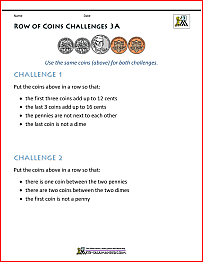
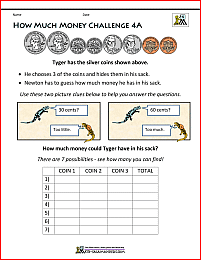
This money worksheet generator below will create a range of money problems in columns to add and subtract in a range of currencies.
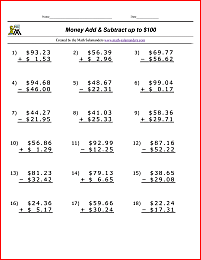
Return to Math Worksheets Generator
Return from Long Division with Money worksheets to Math Salamanders Home Page
Math-Salamanders.com
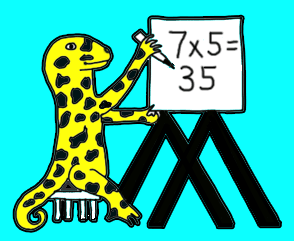
The Math Salamanders hope you enjoy using these free printable Math worksheets and all our other Math games and resources.
We welcome any comments about our site or worksheets on the Facebook comments box at the bottom of every page.
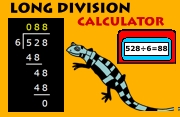

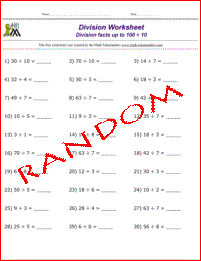
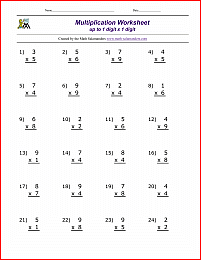
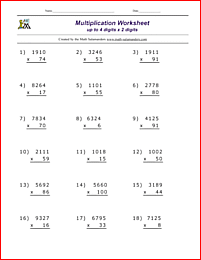

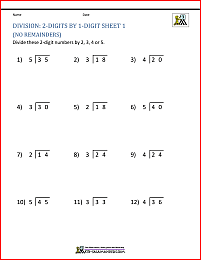
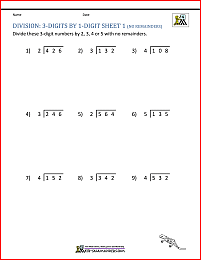
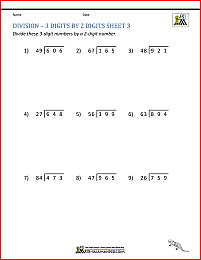
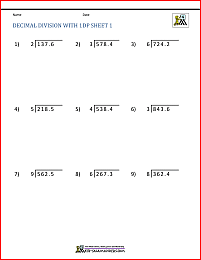
New! Comments
Have your say about the Math resources on this page! Leave me a comment in the box below.